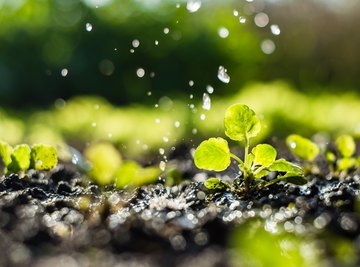
When you feel low on energy and need a snack, you probably just open the refrigerator or rifle through a kitchen drawer. When plants get the urge for an energy bump, their process is a bit more complex and also more direct because they go straight to the source: the sun.
TL;DR (Too Long; Didn't Read)
Plants rely on the process of photosynthesis to capture, convert and store energy directly from the sun. To do this, they require carbon dioxide (CO2) and water (H2O). In the presence of sunlight, these molecules break apart and form glucose (C6H12O6) and oxygen (O2). The chemical formula for this reaction is 6CO2 + 6H2O ------> C6H12O6 + 6O2.
What Is photosynthesis?
In order to produce energy, plants undergo a process called photosynthesis. The chemical formula for photosynthesis is 6CO2 + 6H2O ------> C6H12O6 + 6O2. If you look at the left side of the equation, you see the ingredients that plants require for photosynthesis: six molecules of carbon dioxide (CO2) and six molecules of water (H2O).
Specialized Plant Anatomy
While plants take in carbon dioxide through tiny pores located on their leaves, stems and flowers, they need specialized structures to gather water and move it up through their stems. Most plants use roots to pull water from the earth. To do this, they rely on long, thin root hairs dispersed through the soil. Since the cytoplasm of the root hair cells has lower water potential than the water in the soil, osmosis pulls the water from the root hairs through the root cortex and into the xylem.
The xylem is a system of tubelike vascular bundles that transports water up the plant’s stem and into its leaves. It might be helpful to imagine the xylem as blood vessels stretching through the plant’s body. The process of moving water through the plant is called transpiration.
Water and Photosynthesis
Plants with enough water and carbon dioxide harness the power of photons gathered from sunlight to complete photosynthesis. The six molecules of carbon dioxide and six molecules of water on the left side of the photosynthesis equation break apart and reconfigure into glucose and six molecules of oxygen. The sugar (glucose) can be used for energy immediately or stored for later use while the oxygen releases through the plant’s pores as a waste product.
Since humans can’t perform photosynthesis, they rely on the energy produced and stored by plants. This means that when you make a snack in your kitchen, a plant was responsible for producing all the energy that you consume. Even if the snack is meat-based, plants were the initial energy source for the animal. It’s hard to imagine that the energy that sustains your life and allows you to move started out as carbon dioxide, water and sunlight – but it’s true!
References
About the Author
Melissa Mayer is an eclectic science writer with experience in the fields of molecular biology, proteomics, genomics, microbiology, biobanking and food science. In the niche of science and medical writing, her work includes five years with Thermo Scientific (Accelerating Science blogs), SomaLogic, Mental Floss, the Society for Neuroscience and Healthline. She has also served as interim associate editor for a glossy trade magazine read by pathologists, Clinical Lab Products, and wrote a non-fiction YA book (Coping with Date Rape and Acquaintance Rape). She has two books forthcoming covering the neuroscience of mental health.
